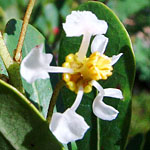

1. Petals pink and/or white, white except 1 petal mostly yellow, pink turning reddish in age, lilac, or lilac fading to white.
2. Style 1; petals strongly reflexed in anthesis so as to hide sepals, abaxially densely sericeous, long-fimbriate on the margin; 1 stamen much longer than the other 9; exotic from Asia escaped from cultivation in Florida.
3. Stipules borne on inner face of base of petiole, partially to completely connate in our species; shrubs or trees.
4. Leaves bearing glands on petiole or abaxial surface of lamina near base, and sometimes on adaxial surface near apex; some bracteoles often terminating in a large gland; styles of uniform thickness or widened at apex, the stigmas truncate or peltate; native in Cuba, probably introduced in the Lesser Antilles.
3. Stipules borne on stem between petioles or on edges of petiole near base, or absent; shrubs, trees, or vines.
5. Shrubs or trees; flowers borne in unbranched axillary umbels or corymbs or short, condensed pseudoracemes; fruit fleshy, mostly indehiscent but in M. verruculosa the red pyrenes separating at maturity.
Malpighia - sample taxa - photos: M. coccigera, M. emarginata, M. fucata,
M. glabra, M. urens - drawings: M. glabra, M. martinicensis
M. glabra, M. urens - drawings: M. glabra, M. martinicensis
6. Flowers borne in umbels of 4; Cuba.
7. Petals usually described as lilac (or blue or purple), sometimes as pink, rarely as white; petioles eglandular or biglandular near apex, the glands usually not prominent; stipules if present borne on stem between petioles, distinct or connate in interpetiolar pairs.
1. Petals yellow or yellow with a red central blotch, or yellow turning red or orange, or yellow and red.
8. Petals abaxially densely sericeous or appressed-tomentose.
9. Calyx glands sessile or absent; Lesser Antilles.
8. Petals abaxially glabrous or at most sparsely sericeous on midrib.
10. Styles slender and subulate, tapering to minute stigmas; subshrubs, shrubs or trees.
11. Leaves usually bearing small marginal glands near base of lamina; pedicels raised on well-developed peduncles; exotic, widely cultivated as an ornamental shrub but apparently not becoming naturalized.
Byrsonima - sample taxa - photos: B. crassifolia,
B. pinetorum, B. spicata, B. verbascifolia - drawing: B. crassifolia
B. pinetorum, B. spicata, B. verbascifolia - drawing: B. crassifolia
10. Styles slender to stout, of uniform thickness or widened at apex, the stigmas large; shrubs, trees, or vines.
12. Styles 3, distinct; apex of styles with stigmas internal and dorsally rounded, truncate, acute, or extended into a hook or foliole-bearing appendage; carpels 3, developing into a schizocarp dividing into dry samaras; mostly vines, some shrubby.
13. Lamina abaxially densely and persistently metallic-sericeous.
14. Pedicels pedunculate; stipules absent or minute triangular structures borne on stem at base of petiole; Puerto Rico.
Heteropterys wydleriana
13. Lamina abaxially glabrous or variously hairy, not densely sericeous.
15. Sepals appressed in anthesis.
16. Posterior petal usually different from lateral petals but not so dramatically different as in previous choice; both bracteoles eglandular.
17. Flowers borne in umbels of (3) 4.
18. Styles with a prominent dorsal extension at apex, the extension hooklike or bearing lateral folioles; stipules distinct, persistent or deciduous.
Tetrapterys - sample taxa - drawings: T. buxifolia, T. inaequalis
2. Styles 2 or 3; petals spreading to reflexed but not hiding sepals, abaxially glabrous or sparsely sericeous on abaxial midrib, entire, erose, or dentate on the margin; stamens without 1 much longer than all the others; native species.
5. Vines; flowers borne in umbels of 4 or congested to elongated pseudoracemes, often branched or terminating leafy stems or both; fruits dry, breaking apart into samaras at maturity.
6. Flowers borne in congested to elongated pseudoracemes of 5 or more flowers.
Banisteriopsis pauciflora: drawing
7. Petals pink; petioles often bearing 2 prominent glands near middle; stipules if present borne on outer edges of base of petiole.
9. Calyx glands peltate, raised on stout stalks that elongate to 1–2 mm during anthesis; Cuba.
11. Leaves eglandular; pedicels sessile or subsessile; native species.
12. Styles 2 or 3, distinct or partly to completely connate; apex of styles with stigmas terminal and without any sort of dorsal extension; carpels 2 or 3, developing into an indehiscent fleshy fruit; shrubs or trees.
Bunchosia - sample taxa - photos: B. glandulifera, B. nitida, B. polystachia - drawings: B. polystachia, B. swartziana
14. Pedicels sessile; stipules elongated, subulate, borne on petiole between middle and apex; Lesser Antilles.
15. Sepals revolute in anthesis.
16. Posterior petal red and deeply fimbriate, very different from lateral petals, which are yellow and erose; 1 bracteole of each pair bearing 1 large abaxial gland; Jamaica.
18. Styles truncate at apex, without any sort of dorsal extension; stipules connate in interpetiolar pairs, the resulting triangular structure persistent or deciduous.
17. Flowers borne in umbels or ± congested pseudoracemes of (5–) 8–20 or more.
Stigmaphyllon - sample taxa - photos: S. bannisterioides, S. ciliatum, S. convolvulifolium, S. emarginatum, S. microphyllum, S. puberum, S. sagraeanum -drawings: S. adenodon, S. bannisterioides, S. emarginatum, S. floribundum, S. puberum
4. Leaves and bracteoles completely eglandular; styles slender and subulate, tapering to minute stigmas.